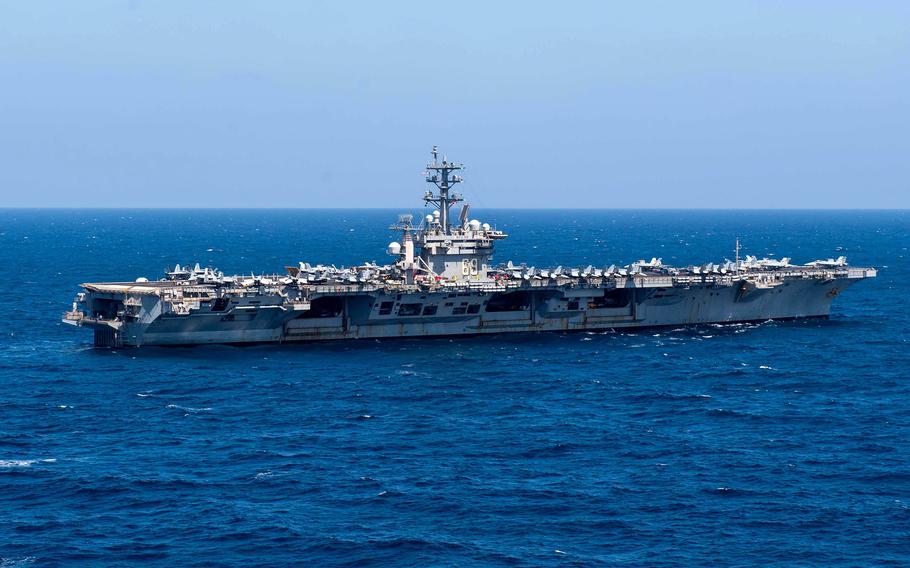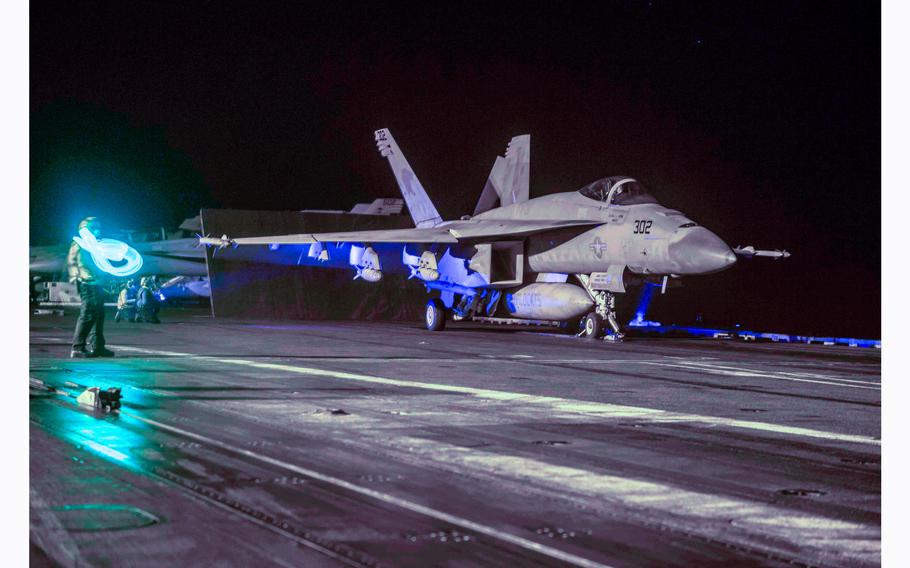
The aircraft carrier USS Dwight D. Eisenhower sails in the Gulf of Aden, Dec.18, 2023. Ike arrived in the eastern Mediterranean Sea on April 26, 2024, leaving the Middle East after five months in the region. (Nicholas Rodriguez/U.S. Navy)
NAPLES, Italy — The Dwight D. Eisenhower Carrier Strike Group left Middle East waters and arrived in the eastern Mediterranean Sea on Friday, on the heels of a Pentagon announcement that construction of a humanitarian sea corridor into Gaza is underway.
The aircraft carrier USS Dwight D. Eisenhower transited the Suez Canal along with the destroyer USS Gravely, U.S. Naval Forces Europe-Africa/U.S. 6th Fleet said in a statement.
The carrier strike group brings more flexibility and capability to 6th Fleet, the Navy said.
Entering the region “is only a small gesture of our ability to project combat superiority to any part of the globe,” Rear Adm. Marc Miguez, commander of Carrier Strike Group 2, said in the statement.
The Navy’s announcement came less than a day after the Pentagon confirmed a mortar attack in the area where a 1,800-foot-long causeway needed to deliver as many as 2 million meals daily eventually will connect to the Gaza shore.
U.S. military personnel are building the temporary pier and a companion floating dock at sea, out of range of the attack, Maj. Gen. Pat Ryder, a Defense Department spokesman, told reporters at a briefing Thursday. Once completed, the pier would be pushed onto the Gaza shore and anchored.
The attack, which caused minimal damage, won’t delay the Joint Logistics Over-the-Shore operation, which is expected to be operational in early May, Ryder said.
Cargo offloaded at the Navy-built dock about 3 miles from Gaza would be ferried to the pier. No U.S. service members would be on the ground in Gaza, and security would be provided by Israel, according to the DOD.
The department still has not specified how the food would be received and distributed, saying previously it was working out those details with the U.S. Agency for International Development and other groups.
Eisenhower’s arrival into the Mediterranean comes after it spent more than five months in the Middle East as part of international efforts to battle Iranian-backed Houthi militants intent on disrupting shipping in the Red Sea.
The carrier and its escorts arrived there in early November after being ordered to the region by Defense Secretary Lloyd Austin as the U.S. worked to keep the Israel-Hamas war from broadening into a larger regional conflict.

An F/A-18E Super Hornet prepares to launch from the aircraft carrier USS Dwight D. Eisenhower in the Red Sea, March 29, 2024. Eisenhower arrived in the eastern Mediterranean Sea on April 26, 2024, leaving the Middle East after five months in the region. (Samantha Alaman/U.S. Navy)
In March, Eisenhower officials said the carrier had been launching about 100 aircraft a day for six to seven days a week since Dec. 31. Those aircraft were completing a variety of missions, such as identifying Houthi movements indicating the potential launch of drones or missiles.
On Thursday, one anti-ship ballistic missile was launched from a Houthi-controlled area of Yemen over the Gulf of Aden, U.S. Central Command said in a statement Friday. There were no injuries or damage reported by U.S. coalition or commercial ships.
The same day, U.S. forces destroyed a surface drone and an aerial drone in separate actions, CENTCOM said.
The Navy didn’t say how long the Eisenhower, which deployed from its homeport in Norfolk, Va., on Oct. 14, would remain in the Mediterranean.
Aircraft carriers are typically scheduled for six-month deployments but often extend their time at sea, particularly during conflicts. For example, USS Gerald R. Ford returned to Norfolk in January after an eight-month deployment in the 6th Fleet area of operations.
In addition to Gravely, the Eisenhower group includes the destroyer USS Mason and the cruiser USS Philippine Sea. It wasn’t clear if the ships, which were last reported in the Red Sea on Monday, would join the Eisenhower.